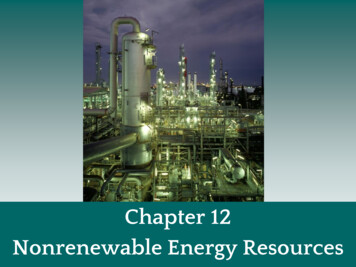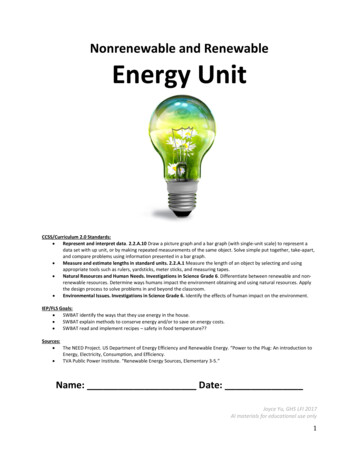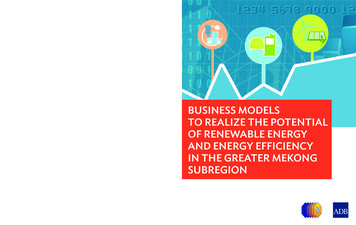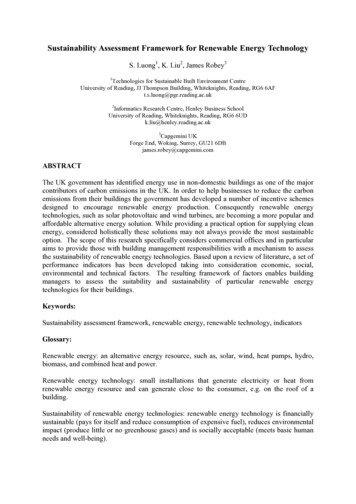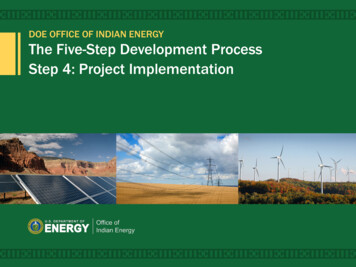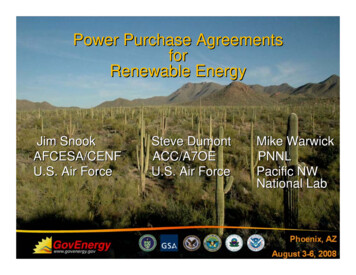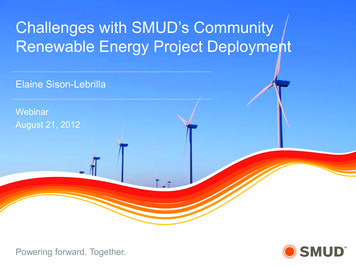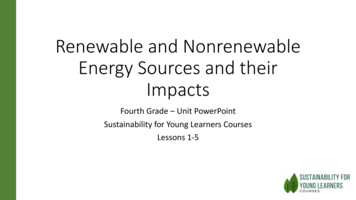
Transcription
Renewable and NonrenewableEnergy Sources and theirImpactsFourth Grade – Unit PowerPointSustainability for Young Learners CoursesLessons 1-5
Primary Standards Covered 4-ESS3-1: Earth and Human Activity - Obtain and combine information todescribe that energy and fuels are derived from natural resources and thattheir uses affect the environment. [Clarification Statement: Examples ofrenewable energy resources could include wind energy, water behinddams, and sunlight; non-renewable energy resources are fossil fuels andfissile materials. Examples of environmental effects could include loss ofhabitat due to dams, loss of habitat due to surface mining, and air pollutionfrom burning of fossil fuels.] SS3.A (4-ESS3-1): Disciplinary Core Ideas: Natural Resources - Energy andfuels that humans use are derived from natural sources, and their useaffects the environment in multiple ways. Some resources are renewableover time, and others are not.
Standard Connections Covered 4-ESS3-2: Constructing Explanations and Designing Solutions Generate and compare multiple solutions to a problem based on howwell they meet the criteria and constraints of the design solution. Literacy Common Core Standards Connections: RI.4.1 Refer to detailsand examples in a text when explaining what the text says explicitlyand when drawing inferences from the text. (4-ESS3-2)
Vocabulary wordsand The Story of a SpoonLesson #1
Vocabulary WordsLesson #1, Activity #1
Energy The power or ability to make something work, move, or be active.Lesson 1, Activity #1
Fossil Fuels Any carbon-containing fuel formed from the remains of prehistoricplants and animals. Ex: coal, petroleum, and natural gasLesson 1, Activity #1
Non-renewable resources Resources that have a limited supply and cannot be replaced bynatural means at a pace that meets its consumption.Lesson 1, Activity #1
Renewable Resources Any source that can or will be replenished naturally over a shortamount of time to meet consumption needs. Ex: wood or solar (sun)Lesson 1, Activity #1
Climate Change A change in global and regional climate patterns attributed to anincrease in atmospheric carbon dioxide from the burning of fossil fuels.Lesson 1, Activity #1
Pollution Pollution happens when the environment is contaminated, or dirtied,by waste, chemicals, and other harmful substances. There are threemain forms of pollution: air, water, and land.Lesson 1, Activity #1
Sustainable Ability to be maintained at a certain rate or level.Lesson 1, Activity #1
Coal A hard black or dark brown substance that is found in the earth andburned as fuel.Lesson 1, Activity #1
Oil Liquid found beneath the earth’s surface used for fuel to power cars.Lesson 1, Activity #1
Natural Gas A mixture of gases found in the earth’s crust and extracted by frackingto be used for cooking and heating.Lesson 1, Activity #1
Solar Energy Radiant energy from the sun that is captured to create energy.Lesson 1, Activity #1
Wind Energy Wind is used to create energy via turbines. The wind turns theturbines, which creates energy and electricity.Lesson 1, Activity #1
Hydropower Producing electricity by converting the power of waves and water intoenergy.Lesson 1, Activity #1
The Story of a SpoonVideo and DiscussionLesson #1, Activity #2
The Story of a Spoon - Video Click here to watch the video Link to the video: https://www.youtube.com/watch?v eg-E1FtjaxYLesson 1, Activity #2.1
The Story of a Spoon - DiscussionLesson 1, Activity #2.2
Coal and OilLesson #2
Coal Reading andHandoutLesson #2, Activity #1
SEARCH CLIMATE KIDSCoal ReadingB The Story of Fossil Fuels byNASA Climate kids. The article for this activitycan be found at this l/QW a&C aTSFAA ceAa4,000aFFA, PaWaPa&Aa1: C ada a ,.I a.SECa aT eI dReaaa .Ta.Ba 1600 ,aa. (Saaa .)aLaa.Wa.Ka.TaaaTaaSa ,C a,aaaaTaaS eaaaaaa.PcDa,a.a.AaFa.O.PTaaaaaa aa B a .Ia aaRaa.Taaaaa.aRRaa Eaaa410 CE aDa AE, a aa.BR.T,a.TaIa .aBaaBaCE aE a." IaaN.Ia1712. I.Iaaaa,aaW a d eCE ea ?R.Taa.T a aaaa.aa aaaa."Caa .W2015,aTaaa.TLesson 2, Activity #1.1
Coal Activity Students will fill out thefollowing section of theactivityLesson 2, Activity #1.2
Oil Reading andHandoutLesson #2, Activity #2
Oil ReadingSEARCH CLIMATE KIDSBig Q estions The Story of Fossil Fuels byNASA Climate kids. The article for this activitycan be found at this /Weather &ClimateAtmosphereWaterEnergPlants & AnimalsThe Stor of Fossil F els, Part 2: OilANcCEaRddA1888, BaBa 66ca . SbaB'Paa-MP,O ,Ga : W aa Na?.Sa. T a caaaababb .Aaaa.DaaHab?:a aPetrole maccc -.Icca bPTaaa,babc a ca.BaBaaa aacccaa.A ,aa .Scaa ac . Ta.TRPa.Bcaa c caaac a c. S.S c aaa,aacabcaaaa,.Wc. I cc a.aa.IaBcab acca . YccaGasolinea(aa cca cba.a.aac c.ac.Pc -aPa acbaaabc aa ac b.BOaaabBa.Ba aba , Ka B. Ka a acbbaa bBa, Ka aa,aa a a a ab .caaca aa caa cca . Icaac).caa.Kerosene accaacaa!a.ILesson 2, Activity #2.1
Oil Activity Students will fill out thefollowing section of the activityLesson 2, Activity #2.2
Oil and CoalDiscussionLesson #2, Activity #3
Coal and Oil Class DiscussionLesson 2, Activity #3
Gas and the Environmental Costof Using NonrenewableResourcesLesson #3
Gas Reading andHandoutLesson #3, Activity #1
SEARCH CLIMATE KIDSGas ReadingBig Q es ions The Story of Fossil Fuels byNASA Climate kids. The article for this activitycan be found at this /Wea her &Clima eA mosphereWa erEnergPlan s & AnimalsThe S or of Fossil F els, Par 3: GasAF eYcacf Mad a a aaa ac -H aa500 BCE,a a a .TU eaNRe,c a,a dc .I ca a c a a d .I,ce e ab ece?,.Faba a aC ad ba bdba .a.Aa,bda daaada . I aac a,a a aaaTa,a d,a dca.a :Tada 200 earsda 500million ears. Ia babadaa,d .Ed ,bc.A aCE. T aba1,900aba a a ba .Tabd-da I a . B, d d ca ca a a100 a d 124aaababc.T da , aaadaACPa d daNica ed Fc cd.Mca dac.Id.Scaa aIadcced a a a aba dc aa.Iaba ab . Na a ac aba.T aaca. Maacc dbc aba a a .T aaaca.d .cbaaaacb ca.c adaaS ,aa adc aac.a,ab,.Lesson 3, Activity #1.1
Gas Activity Students will fill out thefollowing section of the activityLesson 3, Activity #1.2
The King Who Banned Coal - Reading The Story of Fossil Fuels byNASA Climate kids. The article for this activitycan be found at this t/SEARCH CLIMATE KIDSBig QuestionsWeather &ClimateAtmosphereWaterEnergPlants & AnimalsThe Stor of Fossil Fuels, Part 4: NextT eKgWBadI E a dc a1306.da a deec .I aec .T eba ed c a . I a a ebeeeee a aed C aT e P ceS ccefKEd aed baT eaaed. Tc a aC a aee caTI dedee e.aada ead. Maeaed c a , e ee. T e e a,be e ,a da a ae a .ea ea Re. I cae ea ee ae ed. T ea a e.T ee aed ac d a , c e , a d e e dea .Fea e c a edea. Ca , a a e , a de- e edec a ede eee. We , ed bee d ee .ecAe edc ea ac .T ec, e deca d ca e a d a aab a ,ecea , a d aacc e caed.G ba abe eb ebea .G ba aa ece eeEa .Aaaeee USA a d B a . T e1955.AQ e e Teaeae aed ae add e ed,bT eeeae c a eLesson 3, Activity #2.1
The King Who Banned Coal – DiscussionLesson 3, Activity #2.2
Renewable andNonrenewable EnergyVideo and DiscussionLesson #3, Activity #3
Video - Difference Between Renewable andNonrenewable Resources Difference Between Renewableand Nonrenewable Resources Click here to watch the videoLesson 3, Activity #3.1
Video - Safety Smart Science with Bill Nyethe Science Guy : Renewable Energy Safety Smart Sciencewith Bill Nye the ScienceGuy : Renewable Energy– PREVIEW Click here to watch thevideoLesson 3, Activity #3.1
Conversation on Renewable & NonrenewableEnergyLesson 3, Activity #3.2
Climate effects of burning fossilfuels – Introduction to solar,wind, and hydropowerLesson #4
How we useenergy everydayLesson #4, Activity #1
Renewable and Nonrenewable Energy Sources:What it is and how we use it – Worksheet Students will complete thefollowing worksheetLesson 4, Activity #1
RenewableResources Any source that can or will bereplenished naturally over a shortamount of time to meetconsumption needs. Ex: wood orsolar (sun)Non-renewableresources Resources that have a limitedsupply and cannot be replacedby natural means at a pacethat meets its consumption.Lesson 4, Activity #1
Explaining solar, wind,and hydropowerLesson #4, Activity #2
Video – Renewable Energy 101: How doeshydropower work? Renewable Energy 101: How DoesHydroelectricity Work? Click here to watch the videoLesson 4, Activity #2
Video – Renewable Energy 101: How doeswind energy work? Renewable Energy 101: HowDoes Wind Energy Work? Click here to watch the videoLesson 4, Activity #2
Video – Renewable Energy 101: How doessolar energy work? Renewable Energy 101: How DoesSolar Energy Work? Click here to watch the videoLesson 4, Activity #2
Renewable andnonrenewable energysource handoutLesson #4, Activity #3
Video – Renewable Energy 101: How doessolar energy work? Students will complete thefollowing handoutLesson 4, Activity #3
Reducing our use ofnonrenewable resourcesLesson #5
Group Review andBrainstormLesson #5, Activity #1
How can we conserve energy?Lesson 5, Activity #1
Worksheet andSharing SolutionsLesson #5, Activity #2
Worksheet - Renewable and NonrenewableEnergy Sources Students willcomplete thefollowing twosided worksheet.Lesson 5, Activity #2.1
Sharing the Solutions in Groups Optional activity, if time permits.Lesson 5, Activity #2.2
Call to Action:PledgeLesson #5, Activity #3
Call to Action The class will create a pledgeand every student will signthe pledge.Lesson 5, Activity #3
Thank you for your time.Content Creator:Sydney LundMaster of Sustainability LeadershipEnd of the Unit Presentation
dams, and sunlight; non-renewable energy resources are fossil fuels and fissile materials. Examples of environmental effects could include loss of habitat due to dams, loss of habitat due to surface mining, and air pollution from burning of fossil fuels.] SS3.A (4-ESS3-1): Disciplinary Core Ideas: Natural Resources -Energy and


